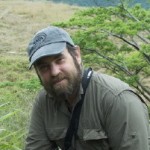
Professor of Biology
Courses Taught:
Current Research
Our laboratory is devoted to understanding the processes that create, maintain, extinguish, and conserve aquatic biodiversity. Our work has historically been very broad, encompassing marine, freshwater, and watershed ecosystems in both temperate and tropical environments.
We work at three scales: ecosystem, community, and organism. At the largest scale, we are working on the fundamental dynamics of coupled human-natural systems (CHANS), in pursuit of a rigorous science of sustainability. We study driving biophysical processes using modern observational and experimental methods, and explore the influence of embedded cultural-social-economic dynamics through a modeling and decision tool approach called MIMES-MIDAS. The models are dynamic and spatially explicit, and we use them to reveal ecosystem service tradeoffs and outcome scenarios under alternative policies. Our models are nourished by data from new observational and analytical methods including nonlinear time series analysis, historical ecology, and high-volume benthic photogrammetry and other forms of remote sensing. The interdisciplinary implications of this work are explored through study of human-natural landscapes in our CHANS program at the Pardee Center for the Study of the Longer-Range Future. Our “home” system is coastal Massachusetts and the Stellwagen Bank National Marine Sanctuary. The CHANS program is a comparative study of three developing world landscapes: the Lower Mekong Basin in Cambodia with a focus on the Tonle Sap (Great Lake); the Gulf of Honduras and Mesoamerican Reef in Belize; and the Nile Valley/Great Lakes region of East Africa. Our empirical contributions to these ecosystem projects come through fieldwork in community ecology, fish biology, fisheries science, and food web reconstruction using stable isotopes.
At the level of community ecology, we study degradation and regenerative processes on coral reefs, with field sites in Kiribati (central Pacific), Brazil, and Belize. We utilize marine reserves and zoning schemes as adaptive management experiments, examining the outcomes of different management regimes with new diagnostics for marine ecosystem health and resilience, such as CHI, the Coral Health Index, and other measures of microbial, benthic and fish community function. We do this work by diving or with remote cameras and sampling devices at greater depths.
At the organismal level, we study reef-building corals under duress from local impacts to anthropogenic climate change. One such project is “Coral Whisperer,” looking at the genes that corals up-regulate to deal with stressors such as climate change, overfishing, and pollution. CW is a consortium, with our lab focused on the ability of coral colonies to defend themselves against daily wear and tear in an ocean altered by declining pH and rising temperature. This work integrates across biological scales, with a special focus on the interactions of fishes, corals, and algae. Our organismal work is currently focused on the biology of Caribbean framework-building corals.
We are highly collaborative, working with several labs at BU (e.g., Gopal, Finnerty, Lobel, Gilmore, Woodcock) as well as close working relationships with conservation organizations (chiefly Conservation International, and the Massachusetts Audubon Society) and state and federal agencies. Our students are encouraged to join the PIs in the invention of conservation solutions, especially for the precarious New England coastal ecosystem and its fisheries.
Books
Kaufman, Les. Do Fishes Get Thirsty?, Franklin Watts, New York, 1991.
Kaufman, Les. Alligators to Zooplankton: A Dictionary of Water Babies, F. Watts, New York, 1991.
Selected Publications
- Jesse G. Hastings, Michael K. Orbach, Leah B. Karrer & Les Kaufman. (2015) Lessons Learned from the Marine Management Area Science Program: Insights for Global Conservation Science Programs. Coastal Management 43:2, 189-216, DOI: 10.1080
- Boumans, R., J. Roman, I. Altman and L. Kaufman. (2015) The Multiscale Integrated Model of Ecosystem Services (MIMES): Simulating the interactions of coupled human and natural systems. Ecosystem Services 12:30-41.
- Gownaris, N. J., E. K. Pikitch, W. O. Ojwang, R. Michener, and L. Kaufman. (2015) Predicting species vulnerability in a massively perturbed system: The fishes of Lake Turkana, Kenya. PLoS One 10(5): e0127027. doi:10.137/journal.pone.0127027.
- Liu H, M. Fogarty MJ, Glaser SM, Altman I, Hsieh CH, Kaufman L, Rosenberg AA, Sugihara G. (2012) Nonlinear dynamic features and co-predictability of the Georges Bank fish community. Marine Ecology Progress Series 464: 195-207.
- Amado-Filho GM, Moura RL, Bastos AC, Salgado LT, Sumida PY, et al. (2012) Rhodolith Beds Are Major CaCO3 Bio-Factories in the Tropical South West Atlantic. PLoS ONE 7 (4): e35171. doi:10.1371/journal.pone.0035171.
- de Aguiar MAM, Baranger M, Baptestini EM, Kaufman L, Bar-Yam Y. (2009) Global patterns of speciation and diversity. Nature 460:384-387.
- Ojwang WO, Kaufman L, Asila AA, Agembe S, Michener B. (2004) Isotopic evidence of functional overlap amongst the resilient pelagic fishes of Lake Victoria, Kenya. Hydrobiologia 529, 27-35.
- Kaufman, LS. (1992) Catastrophic change in species-rich freshwater ecosystems, the lessons of Lake Victoria. Bioscience 42, 846.